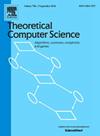Diagonal of pseudoinverse of graph Laplacian: Fast estimation and exact results
IF 0.9
4区 计算机科学
Q3 COMPUTER SCIENCE, THEORY & METHODS
引用次数: 0
Abstract
The diagonal entries of the pseudoinverse of the Laplacian matrix of a graph appear in many important practical applications since they contain much information about the graph, and many relevant quantities can be expressed in terms of them, such as the Kirchhoff index and current flow centrality. However, a naïve approach for computing the diagonal of a matrix inverse has cubic computational complexity in terms of the matrix dimension, which is not acceptable for large graphs with millions of nodes. Thus, rigorous solutions to the diagonal of the Laplacian matrices for general graphs, even for particular graphs are much less. In this paper, we propose a theoretically guaranteed estimation algorithm, which approximates all diagonal entries of the pseudoinverse of a graph Laplacian in nearly linear time with respect to the number of edges in the graph. We execute extensive experiments on real-life networks, which indicate that our algorithm is both efficient and accurate. Also, we determine exact expressions for the diagonal elements of pseudoinverse of the Laplacian matrices for Koch networks and uniform recursive trees, and compare them with those obtained by our approximation algorithm. Finally, we use our algorithm to evaluate the Kirchhoff index of three deterministic model networks, for which the Kirchhoff index can be rigorously determined. These results further show the effectiveness and efficiency of our algorithm.
求助全文
约1分钟内获得全文
求助全文
来源期刊

Theoretical Computer Science
工程技术-计算机:理论方法
CiteScore
2.60
自引率
18.20%
发文量
471
审稿时长
12.6 months
期刊介绍:
Theoretical Computer Science is mathematical and abstract in spirit, but it derives its motivation from practical and everyday computation. Its aim is to understand the nature of computation and, as a consequence of this understanding, provide more efficient methodologies. All papers introducing or studying mathematical, logic and formal concepts and methods are welcome, provided that their motivation is clearly drawn from the field of computing.
 求助内容:
求助内容: 应助结果提醒方式:
应助结果提醒方式:


